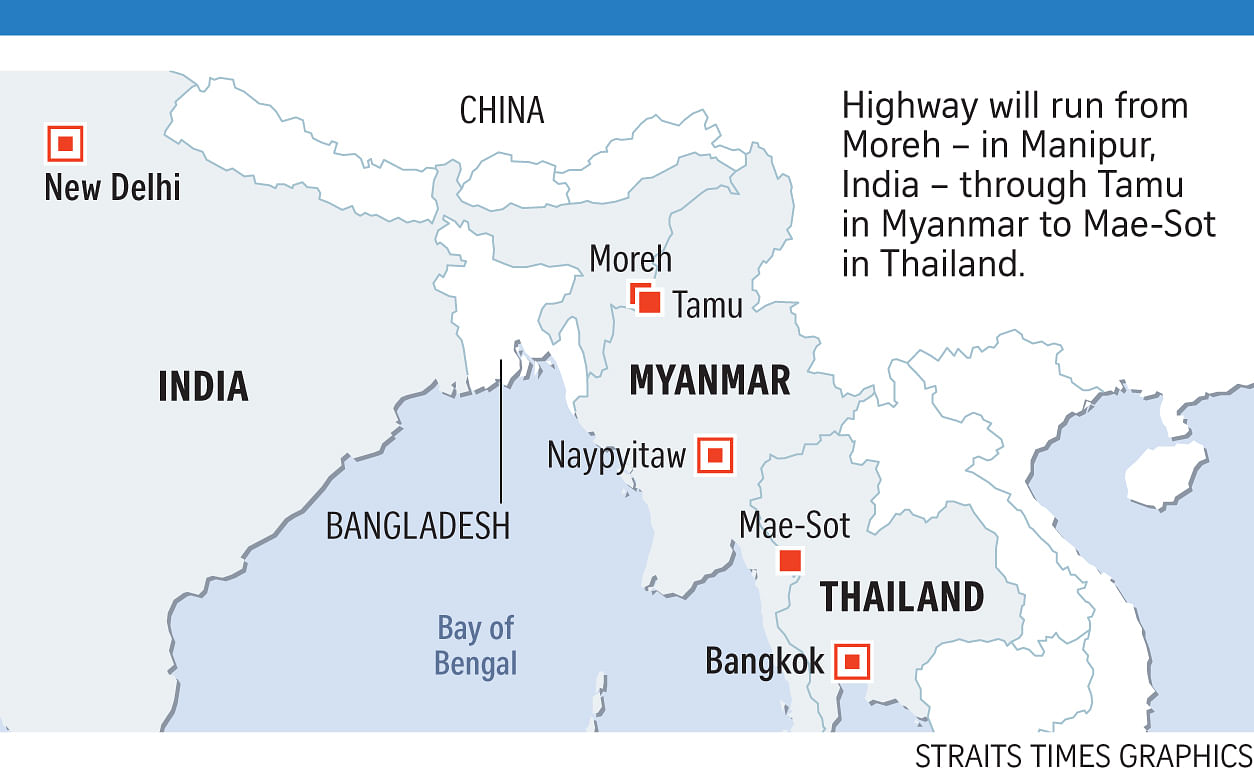NEW DELHI • When Indian Prime Minister Narendra Modi's government approved US$256 million (S$350 million) to upgrade a section of a remote border road last month, few took notice.
Yet India's decision to revive plans for the highway, part of an ambitious 1,360km crossing to link north-eastern India with markets in Thailand and beyond, marks the next phase in the jostle between New Delhi and Beijing for economic and strategic influence in the region.
In the last two years alone, India has assigned over US$4.7 billion in contracts for the development of its border roads, according to government figures, including the highway which will run from Moreh in Manipur, India, through Tamu in Myanmar to Mae-Sot in Thailand.
The construction has taken on new urgency as China pushes ahead with its own vast "One Belt, One Road" infrastructure initiative, expected to involve investments worth more than half a trillion dollars across 62 nations. The intercontinental web of road, rail and trade links has raised concerns among strategic rivals India, Russia, the United States and Japan.
A showcase of the plan - an economic corridor that runs through the Pakistan-administered part of disputed Kashmir, which both India and Pakistan claim - has unsettled equations in the South Asian neighbourhood, where border tensions often simmer.
"With China's growing interest in the region, as its wealth grows, its influence is growing beyond its borders," said Mr K. Yhome, New Delhi-based senior fellow at the Observer Research Foundation. So while China is pushing for a north- south economic corridor under the "One Belt, One Road" initiative, India is aiming to build links with its eastern neighbours, he said.
Under the Modi government's "Act East" policy, India is investing in road and rail links on its north-east borders, where it rubs shoulders with Nepal, Bhutan, Bangladesh, China and Myanmar.

But the plan for the India-Myanmar-Thailand highway is not a new one. It has been on the drawing board since 2001 when it was called the India-Myanmar Friendship Road, according to Mr Vijay Chhibber, India's former roads secretary.
New Delhi has now proposed to further extend the Myanmar-Thailand link to Cambodia, Laos and Vietnam, shortening travel from the Mekong River to India using water transport, in its bid to bind it closer to Asean and the Bay of Bengal Initiative for Multi-Sectoral Technical and Economic Cooperation, according to Mr Chhibber.
The road link will be funded by the Asian Development Bank (ADB) under the South Asian Subregional Economic Cooperation (SASEC) programme. Involving India, Bangladesh, Bhutan, the Maldives, Myanmar, Nepal and Sri Lanka, the programme has doubled investments on infrastructure to US$6 billion since 2011 compared with US$3.5 billion in the previous decade, said Mr Ronald Antonio Q. Butiong, Manila- based director at ADB's Regional Cooperation and Operations Coordination Division.
The SASEC nations, not including Myanmar which joined this February, plan to invest a further US$4 billion on infrastructure projects in the next three years, Mr Butiong said. New projects include the Kaladan multimodal transit transport project connecting India's Mizoram state with ports in Kolkata and Myanmar's Sittwe. India has financed the US$120 million Sittwe port construction, according to SASEC.
India chose not to attend Chinese President Xi Jinping's two-day One Belt One Road summit in May. Three months later, the two nuclear-armed powers are managing a tense military stand-off over a junction between Bhutan, China's Tibet and India's Sikkim.
The Chinese government has repeatedly said its Belt and Road initiative aims to enhance regional connectivity, bringing economic benefits for China's neighbours. It urged New Delhi to shed "misgivings and doubts" about the project.
WASHINGTON POST
